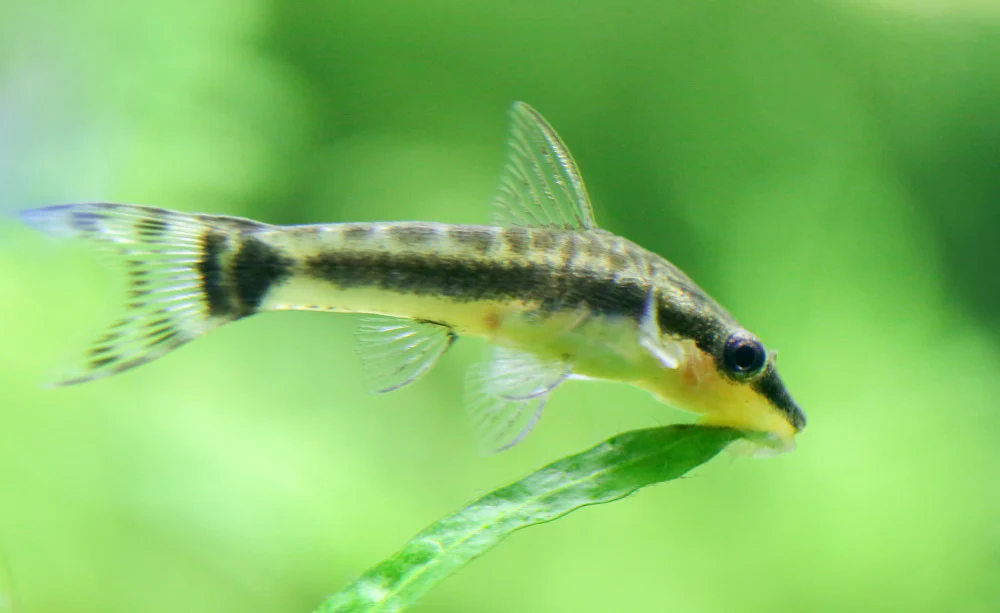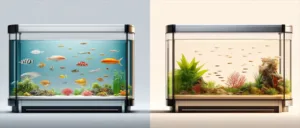Adding an algae eater fish to your aquarium is a great idea. Without getting rid of algae, it can take over your beautiful aquatic environment. Algae eating fish contributes a big share in maintaining the cleanliness of the tank. There are different types of these hardworking little creatures, each with its own unique qualities and advantages.
Table of Contents
Types of Algae Commonly Found in Tanks
Green Algae
In tanks, green algae often indicate a healthy environment by showing good water quality and lighting. But if left uncontrolled, they can become an eyesore very quickly. This kind of algae may cover glass, plants and decorations with a thin film that is green in color.
Brown Algae
Diatoms or brown algae usually appear in new tanks. A slimy brown layer covers surfaces that can be easily wiped off. Brown algae thrive under low light conditions and are typically temporary problem that resolves as the tank matures.
Blue-Green Algae
Technically called cyanobacteria which is bacteria not actually an alga. Blue-green algae can grow fast and produce toxins that harm fish and plants. It forms a slimy mat on surfaces that’s usually greenish-blue but sometimes reddish-purple or blackish-brown too. Controlling this type of algae is difficult because it sticks tightly to objects like rocks or sand grains; even scrubbing won’t remove them completely unless treated with chemicals such as copper sulfate.
Black Beard Algae
Black beard algae are known for being very persistent and hard to get rid of. They attach themselves onto plants, decorations or even gravel forming dark tufts resembling brushes (hence their name). This kind of algae indicates high amounts of nutrients in the water and poor maintenance of tanks.
Hair Algae
Also known as thread algae, it wraps around objects such as plants or decorations very quickly due to their rapid growth rate under strong lighting conditions. Once established they can prove difficult to manage without regular pruning and good tank upkeep.
Effects of Algae Removing Chemicals on Fish Tanks
Chemicals for removing algae in fish tanks offer a fast fix, but there are risks and side effects involved. These substances effectively work on different forms of algae; however, they can upset the fragile balance within your aquarium’s ecosystem. Some chemicals might destroy beneficial bacteria that are necessary for keeping ammonia and nitrite levels down while others may poison or stress fishes as well as other inhabitants if not used correctly. Over-reliance on chemical solutions for algae removal could also lead to increased resistance making future controls harder. It is important that one uses such chemicals sparingly only when all else fails while giving preference to natural methods such as introducing algae eating fish coupled with regular tank maintenance.
Benefits of Having Algae Eating Fish for Aquariums
- Natural Algae Control: Various kinds of algae get eaten by algae eater fish thereby helping to keep tanks clean without using harsh chemicals.
- Eco-Friendly Solution: When you use algae eaters, it promotes an ecological approach towards dealing with algal blooms hence reducing the ecological footprint.
- Chemical-Free Maintenance: The presence of algae eating species eliminates the need for chemical treatments which may harm fish or disrupt natural processes within tanks.
- Improved Water Quality: Excessive nutrients required for algal growth are reduced through these algae eating fish leading to better aquatic habitats.
- Enhanced Aesthetic Appeal: A tidy-looking tank where algae have been controlled looks more beautiful thus providing healthier living space for all organisms living in water bodies.
- Reduced Maintenance Effort: Algae eaters minimize the time and effort needed for manual cleaning, freeing you to derive more pleasure from your aquarium.
- Balanced Ecosystem: Introducing algae eaters helps establish a more stable and self-sufficient aquatic environment.
Types of Algae Eater Fish for Aquariums
Freshwater Algae Eater Fish
| Fish that Eat Algae | Tank Size | Type of Algae They Eat | Compatible Tank Mates |
|---|---|---|---|
| Siamese Algae Eater | 30 gallons | Black beard algae, hair algae, green algae | Tetras, Gouramis, Corydoras |
| Otocinclus Catfish | 10 gallons | Soft green algae, diatoms | Neon Tetras, Rasboras, Small peaceful fish |
| Bristlenose Pleco | 20 gallons | Green algae, soft brown algae | Community fish, Tetras, Guppies |
| Chinese Algae Eater | 30 gallons | Green algae, brown algae | Barbs, Danios, Semi-aggressive fish |
| Twig Catfish | 20 gallons | Soft algae, diatoms | Peaceful community fish, Tetras |
| Florida Flagfish | 20 gallons | Hair algae, black beard algae | Livebearers, Barbs, Danios |
| Rubber Lip Pleco | 30 gallons | Green algae, soft algae | Tetras, Rasboras, Peaceful community fish |
Siamese Algae Eater:
These are popular community tank fish that clean tanks by eating various types of algae such as black beard algae (BBA), hair algae (H/A) and green spot algae (GSA). These fish are peaceful and compatible with many tank mates.
- Type of Algae Eaten: Black beard algae, hair algae, green algae.
- Key Points: A very useful and active algae eating fish which is compatible with most other community species.
- Tank Mates: Tetras, Gouramis, Corydoras, Barbs, Danios.
- Pro Tip: These fish are peaceful and active, getting along well with other community fish that share similar water requirements.
Otocinclus Catfish:
Otocinclus Catfish (or Otos) are small peaceful freshwater aquarium catfish that clean tanks by eating soft green algae and diatoms which might grow on the tank walls or plant leaves. Otos are social fish and do best in groups, adding both aesthetic appeal and functionality to aquariums.
- Type of Algae Eaten: Soft green algae, diatoms.
- Key Points: Small, gentle, good for planted tanks and best kept in groups.
- Tank Mates: Neon Tetras, Rasboras, Small peaceful fish like Guppies, Dwarf Gouramis.
- Pro Tip: Otos are gentle species that thrive together with other small non-aggressive fish especially in planted setups where there is plenty of shade provided by live plants such as Java moss or Anubias barteri.
Bristlenose Pleco:
Plecos are great algae eaters. The Bristlenose Pleco does a fine job of controlling algae growth in the aquarium. This type of Plecostomus eats mainly green algae and soft brown algae but will also consume any leftover food at the bottom of the tank.
- Type of Algae Eaten: Green algae, soft brown algae.
- Key Points: Hardy and can adapt to various sizes of tanks; they help keep surfaces clean too.
- Tank Mates: Community fish like Tetras, Guppies, Mollies, Platies.
- Pro Tip: Bristlenose Plecos are hardy and adaptable, coexisting peacefully with a wide variety of community fish.
Chinese Algae Eater:
Chinese Algae Eaters are known for their strong algae-eating capabilities, particularly green and brown algae. But take care when they grow up because these fish can be territorial. So the behavior should be observed and tank compatibility checked. Despite that, they are still one of the most efficient algae scrapers for aquarium surfaces.
- Type of Algae Eaten: Green algae, brown algae.
- Key Points: They have strong appetite for algae but may get aggressive when mature.
- Tank Mates: Barbs, Danios, Semi-aggressive fish like Tiger Barbs, Larger Tetras.
- Pro Tip: Since they may become territorial; it would be good if you put them together with some slightly more robust tank mates so that the stress level is reduced.
Twig Catfish:
Twig catfish have an interesting appearance and feed on soft algae as well as diatoms. These nocturnal creatures need well-oxygenated water and a quiet environment in order to thrive in captivity settings such as home aquariums.
- Type of Algae Eaten: Soft algae, diatoms.
- Key Points: Unique looking fish that needs calm conditions and oxygen-rich water.
- Tank Mates: Peaceful community fish, Tetras, Small Gouramis.
- Pro Tip: Due to their delicate nature and need for peaceful surroundings, they do best with calm, non-aggressive tank mates.
Florida Flagfish:
They may be small and vibrant but Florida Flagfish are a great addition to freshwater tanks. In fact, they are known to be good at consuming hair algae as well as black beard algae. These fish can sometimes be semi-aggressive so the need for careful selection of tank mates is essential.
- Type of Algae Eaten: Hair algae, black beard algae.
- Key Points: Small and colorful, effective algae eaters but can be semi-aggressive.
- Tank Mates: Livebearers like Guppies, Mollies, Barbs, Danios.
- Pro Tip: Pair them up with some more assertive fish because they can get little aggressive.
Rubber Lip Pleco:
Rubber lip plecos are peaceful and eat green or soft algae. They also require little maintenance which is why beginners find them easy to take care of while maintaining a clean and healthy tank environment.
- Type of Algae Eaten: Green algae, soft algae.
- Key Points: Peaceful and easy to care for, suitable for beginner aquarists.
- Tank Mates: Tetras, Rasboras, Peaceful community fish like Corydoras.
- Pro Tip: These plecos generally coexist well with other non-aggressive fish that enjoy similar water conditions.
Saltwater Algae Eater Fish
| Name of Fish | Tank Size | Type of Algae They Eat | Compatible Tankmates |
|---|---|---|---|
| Foxface Rabbitfish | 75 gallons | Hair algae, macroalgae | Clownfish, Tangs, Wrasses |
| Lawnmower Blenny | 30 gallons | Hair algae, film algae | Clownfish, Gobies, Dwarf Angelfish |
| Yellow Tang | 75 gallons | Green algae, hair algae | Wrasses, Clownfish, Reef-safe fish |
| Kole Tang | 70 gallons | Brown algae, diatoms | Reef-safe fish, Gobies, Wrasses |
| Bicolor Blenny | 20 gallons | Hair algae, film algae | Peaceful community fish, Clownfish |
| Sailfin Tang | 100 gallons | Macroalgae, green algae | Large reef-safe fish, Angelfish |
Foxface Rabbitfish:
The Foxface Rabbitfish are brightly colored and great at eating hair algae. They also consume macroalgae but can grow quite large thus needing more space to swim around in the aquarium. They have a distinctive look and are famous for their ability to keep saltwater tanks clean by feeding on these types of algae.
- Type of Algae Eaten: Hair algae, macroalgae.
- Key Points: Vibrant and effective; require larger tanks due to their size when fully grown.
- Tank Mates: Clownfish, Tangs, Wrasses, Peaceful reef-safe fish.
- Pro Tip: In larger systems Foxface Rabbitfish can mix with other non-aggressive reef safe species provided there is enough swimming space available for all involved parties.
Lawnmower Blenny:
Lawnmower Blennies vigorously eat hair algae as well as film algae. Their behavior is interesting especially when they keep grazing over rocks or any surface that might have some green growth on it which makes them both fun to watch and useful in terms of maintaining a healthy saltwater aquarium.
- Type of Algae Eaten: Hair algae, film algae.
- Key Points: Known for their voracious appetite for algae and quirky behavior.
- Tank Mates: Clownfish, Gobies, Dwarf Angelfish, Other peaceful reef fish.
- Pro Tip: Lawnmower blennies should be kept with other peaceful species that are reef-safe.
Yellow Tang:
The yellow tang is an attractive fish known for its ability to eat green as well as hair type of algae. It requires a lot of swimming room and stable water conditions must be provided in order for it to thrive within any saltwater tank setup. These qualities make this particular species highly popular among marine enthusiasts who want their aquariums looking good at all times while also keeping them healthy.
- Type of Algae Eaten: Green algae, hair algae.
- Key Points: Popular because of its bright coloration; needs plenty of swimming space and stable water parameters.
- Tank Mates: Wrasses, Clownfish, Reef-safe fish like Dwarf Angelfish.
- Pro Tip: Yellow Tang is a vigorous swimmer, it requires a peaceful community and therefore does well in reef tanks that have other lively but not aggressive fish.
Kole Tang:
Kole Tangs are efficient eaters of brown algae or diatoms. They can thrive in different saltwater aquariums because they are tough and adaptable. It is worth noting that these fish constantly feed on the surfaces of the tank which helps to keep them clean from algae.
- Type of Algae Eaten: Brown algae, diatoms.
- Key Points: Effective and hardy, suitable for a variety of saltwater aquariums.
- Tank Mates: Reef-safe fish, Gobies, Wrasses, Other peaceful Tangs.
- Pro Tip: Kole Tangs are effective algae eaters and do well in a community of peaceful reef fish, helping to keep the tank clean.
Bicolor Blenny:
Bicolor Blennies are small active hair and film algae eaters. They work best in small reef tanks where there is less space for them to move around. These blennies have unique colors which make them stand out among other marine organisms. They help control algal blooms through grazing activities thereby providing both aesthetic beauty as well ecological value within an aquarium setup.
- Type of Algae Eaten: Hair algae, film algae.
- Key Points: Small and active, great for smaller reef tanks, known for their distinctive coloration.
- Tank Mates: Peaceful community fish, Clownfish, Gobies, Small reef fish.
- Pro Tip: Their size makes them perfect companions with other small non-aggressive fish found in reefs thus enabling hobbyists achieve their goals easily while setting up marine tanks at home.
Sailfin Tang:
Sailfin Tangs have large fins and bright colors which make them look stunning. They feed on macroalgae and green algae too though they need larger tanks and stable conditions for optimum growth. These fish are beautiful because of their appearance and ability to eat up algae thereby acting like natural filters for big saltwater aquariums filled with different types of marine life forms.
- Type of Algae Eaten: Macroalgae, green algae.
- Key Points: Impressive fins and coloration, requires a larger tank and stable conditions.
- Tank Mates: Large reef-safe fish, Angelfish, Wrasses, Clownfish.
- Pro Tip: Sailfin Tangs are magnificent swimmers that need big tanks hence can go along with other large peaceful reef fish.
By picking the right species of algae eater fish according to your tank’s setup you will ensure that it remains clean, healthy and visually appealing place for both you as well as those aquatic creatures.
Conclusion
Algae eater fish consume a lot of different kinds of algae. Apart from their visual appeal, they are also responsible for Eco-friendly cleanliness of our aquariums. It doesn’t matter whether you have a small community tank or a large reef setup; what matters most is choosing the right type of an algae eater which will serve your purpose best.
Frequently Asked Questions
Can algae eaters live in saltwater tanks?
While most algae eaters are freshwater fish, there are some saltwater varieties available. However, these are generally less efficient at algae removal than their freshwater counterparts.
What to do if my algae eater dies?
If your algae eater dies, it’s crucial to determine the cause to prevent any issues from affecting other fish in your tank. Remove the deceased fish immediately and check water parameters.
How many algae eaters do I need for different tank sizes?
The number of algae eaters you’ll need depends on the size of your tank and the extent of the algae problem. As a general rule, one algae eater per 10-20 gallons is a good starting point.
Do fish eat algae?
Yes, many species consume it as part of their diet thus helping to keep tanks clean from different types of algae.
What fish eat algae?
Several fish are known for their algae-eating habits, including Siamese Algae Eaters, Otocinclus Catfish, Bristlenose Plecos, and various types of Tangs and Blennies in saltwater aquariums. These fish effectively control algae growth in tanks.
What fish eat brown algae?
The Otocinclus Catfish, Siamese Algae Eaters and the Bristlenose Pleco among other Plecos are some of the fish that feed on brown algae or diatom. They help in cleaning tanks by eating such kinds of algae.
What fish eat hair algae?
Hair algae can be controlled by different types of fishes including Siamese Algae Eaters, Florida Flagfish as well as some Blennies for example Lawnmower Blenny which is found in saltwater tanks.
Do Koi fish eat algae?
Yes, Koi fish do eat algae. Although not specialized algae grazers like some other fish, Koi will still nibble at pond surfaces and rocks thus contributing towards cleanliness in aquatic environment.
Do algae eaters eat fish?
Normally, fish that feed on algae do not eat other fish. However, when they grow older, some species such as the Chinese Algae Eater may become territorial and aggressive towards other fishes resulting in their injury or death. That’s why it is important to select a peaceful type of an algae eater which can live harmoniously with its tank mates.
What fish eat black beard algae?
Siamese Algae Eaters and Florida Flagfish are examples of fishes that have been reported to consume black beard algae. These types of fishes can help control this stubborn form of algae.
Do algae eaters eat fish food?
Yes, besides consuming algae, these creatures will also eat food meant for other fish in the aquarium. To ensure all the necessary nutrients are received by them, it is advisable to supplement their diet with blanched vegetables and wafers made from algae.
Do Betta fish eat algae?
No, Betta fish cannot be relied upon as effective controllers for this problem since they lack interest in eating it most times. Although occasionally pecking at small strands would happen but still not enough quantity is consumed for controlling its growth within tanks.
Can an algae eater live with a Betta fish?
Some kinds like Otocinclus Catfish and small Plecos might coexist peacefully with Bettas but there should be enough space provided along with hiding spots since these two need different living environments.
Do algae eaters eat fish poop?
No, algae eaters do not eat fish poop. They primarily consume algae and biofilm. Fish poop should be removed through regular tank maintenance and cleaning to maintain a healthy aquarium environment.



